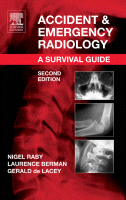Browse content
Table of contents
Actions for selected chapters
- Full text access
- Book chapterNo access
1 - BASIC PRINCIPLES
Pages 2-15 - Book chapterNo access
2 - SKULL
Pages 16-45 - Book chapterNo access
3 - FACE
Pages 46-67 - Book chapterNo access
4 - SHOULDER
Pages 68-89 - Book chapterNo access
5 - ELBOW
Pages 90-107 - Book chapterNo access
6 - WRIST AND DISTAL FOREARM
Pages 108-129 - Book chapterNo access
7 - HAND AND FINGERS
Pages 130-143 - Book chapterNo access
8 - CERVICAL SPINE
Pages 144-169 - Book chapterNo access
9 - THORACIC AND LUMBAR SPINE
Pages 170-179 - Book chapterNo access
10 - PELVIS
Pages 180-189 - Book chapterNo access
11 - HIP AND PROXIMAL FEMUR
Pages 190-199 - Book chapterNo access
12 - KNEE
Pages 200-215 - Book chapterNo access
13 - ANKLE AND HINDFOOT
Pages 216-235 - Book chapterNo access
14 - MIDFOOT AND FOREFOOT
Pages 236-245 - Book chapterNo access
15 - CHEST
Pages 246-269 - Book chapterNo access
16 - ABDOMEN
Pages 270-281 - Book chapterNo access
17 - PENETRATING FOREIGN BODIES
Pages 282-289 - Book chapterNo access
18 - SWALLOWED FOREIGN BODIES
Pages 290-305 - Book chapterNo access
19 - PARTICULAR PAEDIATRIC POINTS
Pages 306-325 - Book chapterNo access
20 - GLOSSARY: Commonly used words, terms and definitions
Pages 326-336 - Book chapterNo access
INDEX
Pages 337-341
About the book
Some multimedia content, downloadable content, and/or access to additional websites may not be available if accessing this title through ScienceDirect.
Description
Perfect for the non-specialist, this pocket guide focuses on common injuries and those abnormalities that are frequently overlooked or misinterpreted in the emergency department...and gives key indicators when a radiologist should be consulted. Using a concise and systematic approach, it explains how to examine and accurately interpret x-rays. Each chapter focuses on the basic radiographs required, important anatomy, normal variants, a system for inspecting suggested views, types of injury, and ends with a summary of key points.
Perfect for the non-specialist, this pocket guide focuses on common injuries and those abnormalities that are frequently overlooked or misinterpreted in the emergency department...and gives key indicators when a radiologist should be consulted. Using a concise and systematic approach, it explains how to examine and accurately interpret x-rays. Each chapter focuses on the basic radiographs required, important anatomy, normal variants, a system for inspecting suggested views, types of injury, and ends with a summary of key points.
Key Features
- Highlights common sources of error and diagnostic difficulty.
- Emphasizes pitfalls and associated abnormalities.
- Provides a summary of key points at the end of each chapter for a quick overview of the most important features.
- Accompanies radiographs with line-drawings to explain difficult concepts.
- Completely revises and updates all chapters.
- Provides greater coverage of chest radiology.
- Features more conceptual line drawings, tables, and summary charts, and improved quality of images.
- Highlights common sources of error and diagnostic difficulty.
- Emphasizes pitfalls and associated abnormalities.
- Provides a summary of key points at the end of each chapter for a quick overview of the most important features.
- Accompanies radiographs with line-drawings to explain difficult concepts.
- Completely revises and updates all chapters.
- Provides greater coverage of chest radiology.
- Features more conceptual line drawings, tables, and summary charts, and improved quality of images.
Details
ISBN
978-0-7020-2667-6
Language
English
Published
2005
Copyright
Copyright © 2005 Elsevier Ltd. All rights reserved
Imprint
Saunders Ltd.
